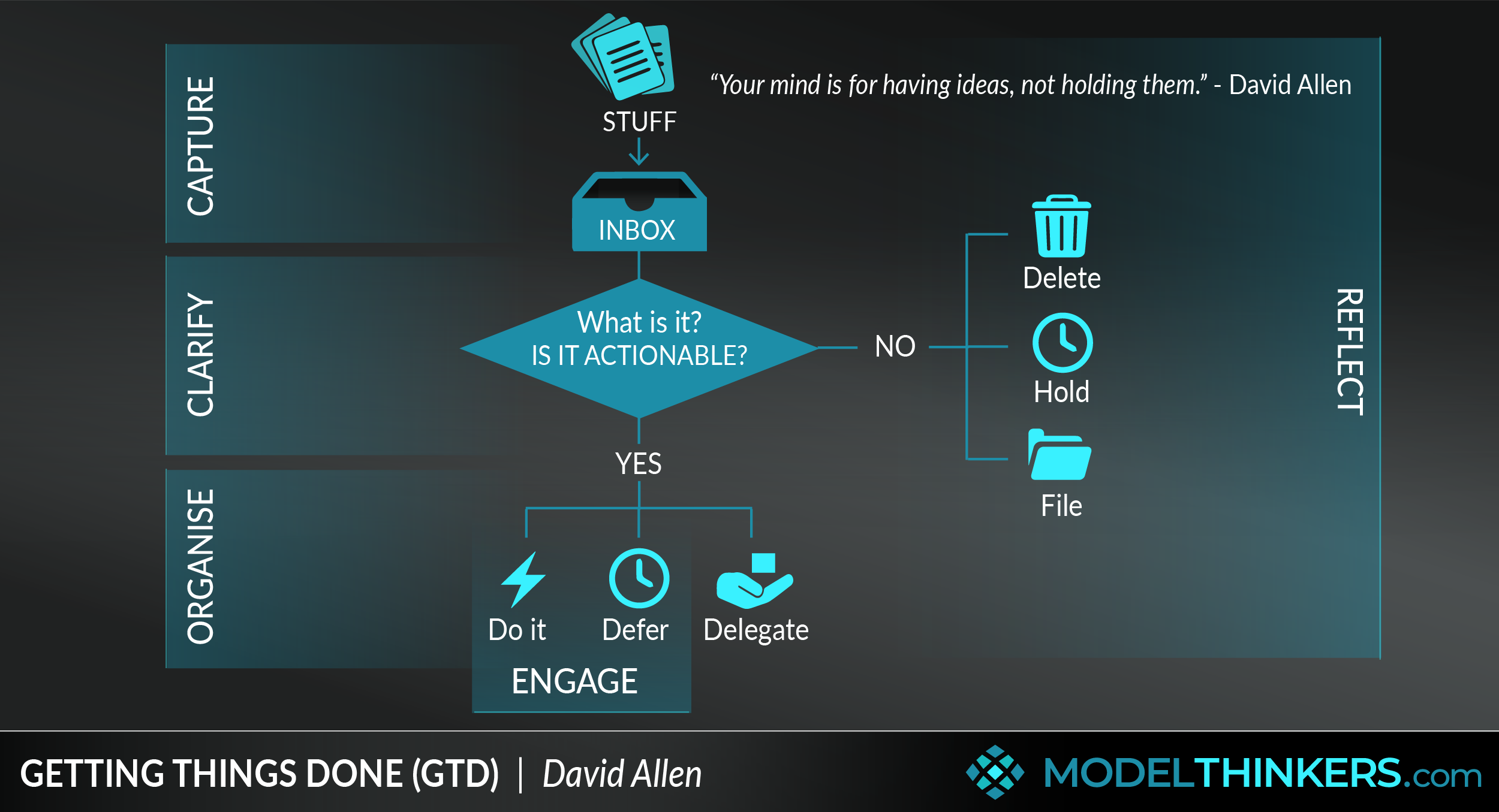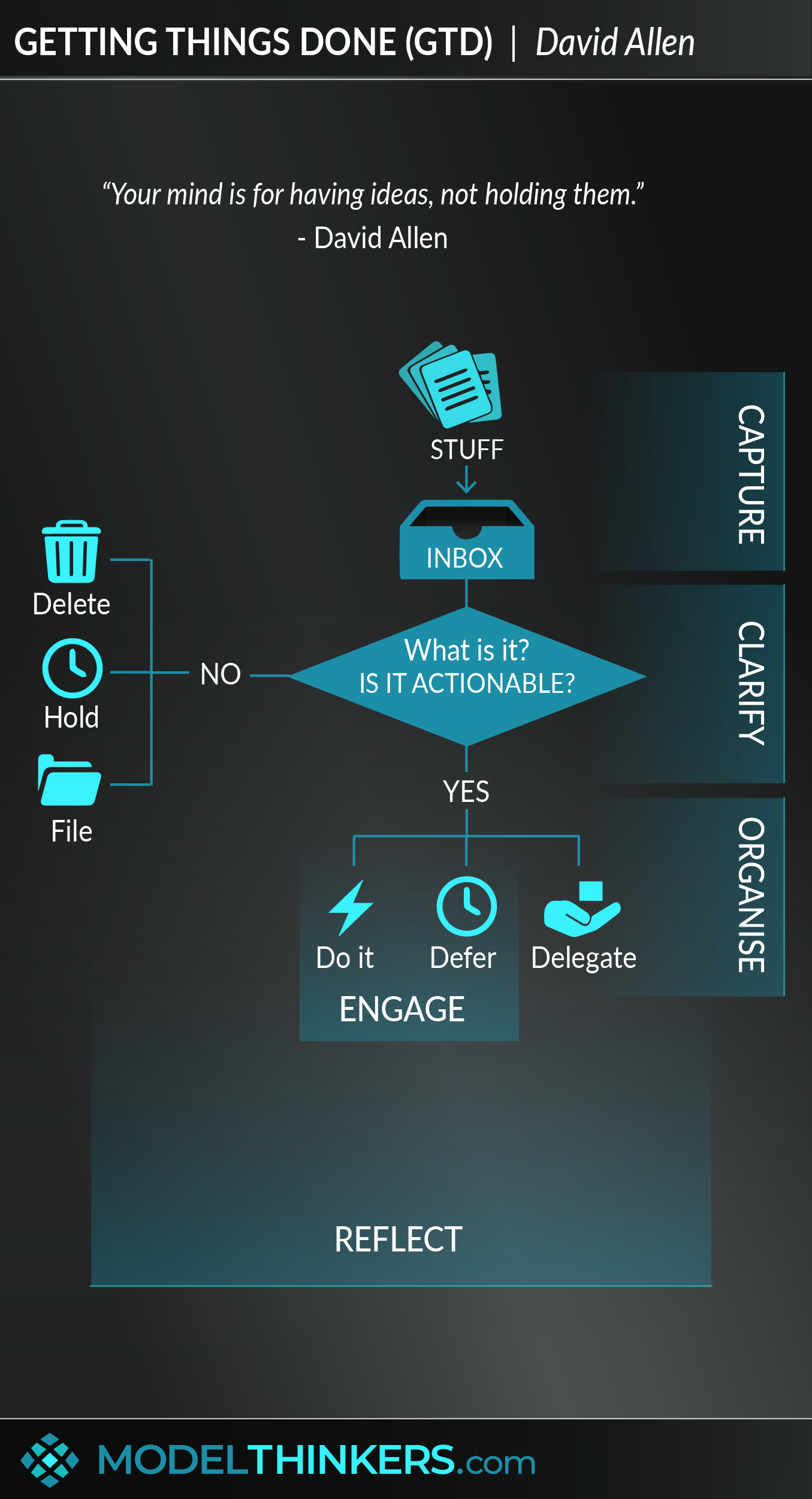

 0 saved
0 saved
 19.6K views
19.6K views








Decades since its inception, Dave Allen’s approach to productivity continues to influence millions with countless enthusiastic, almost evangelical supporters.
Getting Things Done (GTD) is a productivity approach that helps you to clear your mind of ‘stuff’ and focus on important tasks. At a basic level, it follows a process of capturing everything; clarifying what those things involve; organising them accordingly; reviewing them regularly; and getting the important things done at the right time.
THE 5 STEPS BEHIND GTD.
Allen explains that GTD is not about improving how you manage your time, it’s about improving how you manage your attention and focus. To that end the five steps in more detail are:
-
Capture: Get stuff out of your head by capturing anything on your mind, particularly things that feel incomplete or pending. Write them down, type them out, use an app, or anything — just get them out of your head.
-
Clarify: First, consider whether that thing that you’ve captured is actionable?
-
If it’s not actionable you have three choices:
-
Delete it.
-
Hold it in a Tickler file for future review (see below).
-
File it as reference material.
-
-
If it is actionable, consider whether it will take more than one action, then:
-
Do it If it takes less than 2 minutes.
-
Delegate it f you’re not the right person to do it.
-
Defer it, If you have to do it and it takes more than 2 minutes add it to your Next Actions and schedule it in your calendar.
-
-
If it needs to be broken down into smaller actions, add it your project list.
-
-
Organise: establish reminders and prompts for your categorised tasks. Two methods you might want to focus on are:
-
Context prompts: for example using @home @computer @car @work tags to identify where you might execute on specific actions so you can cluster them in an environment.
-
Tickler file: this is a file with 43 folders, one for 31 days of a month plus one each for the 12 months of a year. Use these as time-based reminders by categorising your tasks on a day or month.
-
-
Reflect: Update and review regularly to regain control and focus. This involves making time to step back and ensure that you are on the right track.
-
Engage: take action with confidence, focus, and clarity.
THE COGNITIVE LOAD OF ‘OPEN LOOPS.’
“Your mind is for having ideas, not holding them.” This quote from Allen points to one of the core principles behind GTD. For Allen, this means closing ‘open loops’, which he describes as unfinished and pending tasks. Examples of open loops include a commitment you’ve made but haven’t acted upon, or the job that you’ve been putting off. Even tasks you have on your to-do list might lead to open loops because, Allen argues, that most of them are “amorphous blobs of undoability.” He stresses the importance of defining what ‘done’ looks like for each task, so they have a clear end and can be closed out — practically and cleared from your mind.
The idea of ‘open loops’ and the cleansing power of mental closure aligns with research behind the Zeigarnik Effect and has the potential to better clear your mind and focus on what’s important.
THE 2-MINUTE RULE.
Allen's 2-minute rule means that if something will take less than 2-minutes to action, you should do it immediately. The rationalisation here is that it would take around 2-minutes to effectively capture, clarify and organise that task, so getting it done immediately will not cost you any additional time from the disruption. That said, where possible, you’d ideally be conscious about when to accept and address such tasks at all. After all, remember Deep Work and that multitasking is not a thing.
IN YOUR LATTICEWORK.
As described above, the idea of closing open loops aligns strongly with the Zeigarnik Effect and has elements that connect to the myth of multitasking and the power of Deep Work. The potential overwhelm that GTD aims to solve also is explored with the Paradox of Choice.
Consider applying GTD with a Kanban system and/or in combination with other prioritisation models such as the Pareto Principle or the Eisenhower Matrix. Finally, consider how you can better embed GTD as part of a Habit.




-
Collect what’s grabbing your attention.
Write down everything that is on your mind, from tasks, ideas, jobs you’re avoiding — everything. Just get them out of your head.
-
Clarify and categorise them.
Establish whether something is actionable or not. If it isn’t make a decision on whether to throw it, file it, or hold it. If it is, decide whether to do it (especially if it will take less than 2-minutes), delegate it , or defer it.
-
Organise your list and tasks.
This is where you set context prompts for your tasks, and schedule reminders in your calendar.
-
Reflect and think through the big picture.
Schedule a regular time to consider the big picture and ensure that you are moving in the right direction.
-
Engage.
With the above sorted your mind should be clear and your actions should be lined up before you, so take action and get things done.
A consistent criticism of GTD is its level of complexity and that ‘maintaining your system’ can take too long, especially if your tasks are relatively straightforward and defined. The fact that so many people have posted videos explaining it, run courses on it, and written books on it will feed that fire — that it takes too much work to really ‘get’. Defenders of GTD will argue that this just means you can apply it at the level that suits your context, and streamline your process where possible.
Another criticism of GTD is that it eschews traditional prioritisation for context-driven actions. So you’ll do a bundle of actions while you’re out in your car, rather than potentially choosing the priority actions for your day no matter where you have to be for them.
But perhaps the most fundamental criticism of GTD is a broader one leveled against the pressure for greater personal productivity. Cal Newport captured this well, when he wrote:
“A worker might send fewer e-mail requests to others, and become more structured about her work, but she’ll still receive requests from everyone else; meanwhile, if she decides to decrease the amount of time that she spends engaging with this harried digital din, she slows down other people’s work, creating frustration.
“In this context, the shortcomings of personal-productivity systems like G.T.D. become clear. They don’t directly address the fundamental problem: the insidiously haphazard way that work unfolds at the organizational level.”
GTD Systems.
There are many practitioners of GTD willing to wax lyrical about the perfect system that they’ve found. From advocates of an old-school notepad to using apps as diverse as Trello, Asana, Monday, Weekdone, FacileThings, Omnifocus and so many more. The point really is that you can apply it to any app, so experiment with what works for you and also appreciate that it might change over time.
d
David Allen first published Getting Things Done in 2001 and a revised version in 2015. It had a big impact at its publication, gaining support from enthusiastic, bordering on evangelistic supporters it had early adoption in the tech community and was popular in broader corporate circles. Cal Newport has written about GTD building on the trend of corporate productivity championed by Peter Drucker into a Personal Productivity model that connected with the growth of ‘knowledge workers’, or workers who relied on their mental ability over physical labour.
David Allen continues to work as a consultant around productivity and the GTD approach.
 My Notes
My Notes
Oops, That’s Members’ Only!
Fortunately, it only costs US$5/month to Join ModelThinkers and access everything so that you can rapidly discover, learn, and apply the world’s most powerful ideas.
ModelThinkers membership at a glance:






“Yeah, we hate pop ups too. But we wanted to let you know that, with ModelThinkers, we’re making it easier for you to adapt, innovate and create value. We hope you’ll join us and the growing community of ModelThinkers today.”



























































































